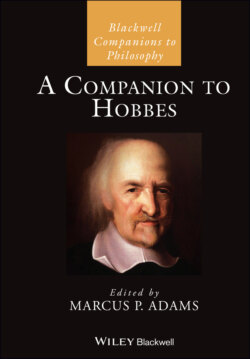Читать книгу A Companion to Hobbes - Группа авторов - Страница 54
4 Explanations in Hobbes’s Optics and Natural Philosophy
ОглавлениеMARCUS P. ADAMS
In the Epistle Dedicatory of De corpore, Thomas Hobbes claimed that in his time natural philosophy was only in its infancy, having been born with work of Copernicus, Galileo, Harvey, Kepler, Gassendi, and Mersenne (EW I.ix). Although he portrayed himself as the progenitor of civil philosophy, Hobbes also saw himself as contributing to the (in his opinion) juvenile disciplines of optics and natural philosophy. For example, he claimed in 1646 in A Minute or First Draught of the Optiques (hereafter Minute) that he would “deserve the Reputation of having beene the first to lay the ground of two Sciences, this of Opticques, the most curious, and that other of naturall Justice, which I have done in my book De cive, the most profitable of all other” (Hobbes 1983 [1646], 622; cf. EW VII.471).
Hobbes’s bombastic appraisals of himself aside, his contemporaries took his work in optics seriously and Mersenne included an optical treatise of Hobbes’s in Ballistica (1644).1 Hobbes’s 1641 correspondence with Descartes ended with Descartes saying that he “to have nothing more to do with [Hobbes]” because he thought that Hobbes was trying to gain reputation at Descartes’ expense (AT III.320, CSMK 173), but their correspondence shows disagreements between them concerning, for example, refraction in media and the nature of light (see Letters 29–30 and 32–4 in Hobbes 1994a).
Hobbes’s interests in optics should make sense to anyone familiar with the opening chapters of Leviathan. If one seeks to ground all ideas, and thus all knowledge, in sensation, as Hobbes declares in Leviathan chapter 1 (2012, 22; 1651, 3), then developing an optical theory is paramount. Hobbes’s aim in optics, and in natural philosophy generally, was to explain various phenomena in a way that cohered with mechanical philosophy, so, for example, no appeal to species would be permitted. However, rather than looking to Hobbes’s optics and natural philosophy in themselves, the present chapter explores these areas of Hobbes’s thought from another angle: to show that Hobbes’s explanations in optics take the same form as how he understood ideal explanations in natural philosophy. When providing an explanation in both of these disciplines Hobbes appeals both to everyday, unaided sense experience and to geometry. Hobbes explicitly identifies this form of explanation with “mixed-mathematics,” and he goes so far as to say that “true physics” depends upon geometry in this way (Hobbes 1994b [1658], 42; OL II.93).
First, I discuss Hobbes’s statements about the structure of philosophy and suggest that a focus on these reflections – rather than on Hobbes’s explanatory practice – has led some scholars to understand Hobbes as an armchair speculative philosopher, both in his own natural-philosophy endeavors and his well-known criticisms of Robert Boyle and other experimental philosophers. Beyond Hobbes’s statements about natural philosophy, I argue that a more complete understanding of his natural philosophy must also consider his practice of explaining in natural philosophy and optics. Next, I show that explanations in optics and natural philosophy are, according to Hobbes, ideally a mixture of appeals to everyday sense experience and Hobbes’s own a priori geometry by providing two case studies: a case study from Hobbes’s optics in De homine II and a case study of Hobbes’s explanation of sense in De corpore XXV. Rather being an armchair speculative philosopher who devalued experience, in Hobbes’s practice of explanation everyday experience, not experiments like those of the Royal Society, played an integral role insofar as it provided what was to be explained (the “that”) while geometry provided the probable cause (the “why”).
